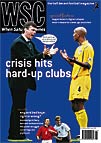 Alan Moore explains why the Gulf kingdom is unlikely to spring many surprises at this year's World Cup, not to attract any high profile foreign players
Alan Moore explains why the Gulf kingdom is unlikely to spring many surprises at this year's World Cup, not to attract any high profile foreign players
Saudi Arabia arrived on the international scene with one of the greatest goals in World Cup history. Saed Al Owarain’s mazy run and shot against Belgium in 1994 lit the fuse for a footballing explosion in one of the most private and secretive countries on earth. But despite another World Cup qualification this time around, their third in a row, Saudi football has been in steady decline for some time.
The oil boom of the Eighties saw magnificent stadiums spring up from the desert sands, before anyone had worked out how to fill them. In a country where, contrary to western cliches, the majority subsist near the poverty line, going to live events isn’t as important as knowing where the next meal is coming from. In addition half of the population – women – are not allowed attend matches. As a result, attendances are generally poor, rising only for big matches when tickets are greatly reduced in price or free.
Apart from the cost of living, the main problem lies with the club owners – high-ranking princes, who see the game as an extension of their power and prestige, own the top teams in the country. Clubs like Al Hilal, Al Ittihad and Al Shabab all have wealthy backers who pump in cash , but with strings attached. It is the owners’ right to choose who should play, the tactics used and even whether or not the team needs to win.
Strange results are the norm here. Lower teams, also partially owned by princes linked with top sides, roll over when their higher-ranked opponents need the goals. Many coaches have bitten the dust because their ethics got in the way of their orders. The most recent example was Al Hilal’s Artur Jorge (formerly national coach of Portugal), who got the boot for refusing to select a player “owned” by one of the princes, despite the fact that the club led the league and were playing tremendous football. Jorge’s replacement, the former coach of Colombia Francisco Maturana, knew where his next pay cheque was coming from and selected the player in question.
Constant coaching changes, “mysterious” transfers and unusual results create a product that television has an increasingly difficult job selling. Fans prefer to watch the top European games available on satellite. There are a fair few European players here, and some Africans, but no household names. Italia 90 star Roberto Donadoni once played with Ittihad, as did Dalian Atkinson. The lesser teams are populated with cheap imports, often from former Soviet republics such as Uzbekistan. The Brazilian influence that began when Rivelino signed for Al Hilal of Riyadh in 1978 has dissipated, though Romário was paid US$1 million to play three games for Al Ittifaq to keep them in the top flight in 1994-95 (he hardly touched a ball, coming on as sub in two of the games).
Substandard foreign buys frustrate fans who believe the wealthy princes could buy internationally recognised stars. The truth is somewhat different. With the economy shrinking, the game’s backers are looking elsewhere for investment opportunities. Money is moving abroad and into other sports. Currently Saudi cash is spent on such enterprises as the Mighty Ducks of Anaheim (ice hockey), the Toronto Blue Jays (baseball) and Toyota Motorsports.
A constant bone of contention for followers is the complete insularity of the sport. Players can’t leave Saudi Arabia without express permission of the club’s owners or sponsors, even if they have no contract. The peculiarities of Saudi emigration laws and an endemic backhander culture have meant foreign clubs are extremely reluctant to try tempting players abroad. That Wolves were allowed to take Sami Al Jaber on loan in 2000 was very surprising – a recent approach from Brescia for him stalled because too many people here wanted a slice of the pie. Valencia were regularly linked with an outstanding young striker, Nawaf Al Tamyat, until his club owner said he would never leave the country. In a country with pliable labour laws and no unions, players daren’t hope for new challenges.
Football is still the nation’s No 1 sport, but the single biggest problem in the kingdom is the lack of facilities. Top clubs play and train on immaculate pitches, but 99 per cent of players make do with sand or tarmac. An average player’s ball control outranks his counterpart in Britain, but put them on grass and fundamental flaws appear. The game becomes individual, devoid of physical contact or tackling, and lacks cohesion. If Saudi Arabia is to make another impact at international level, it must build from the bottom up.
From WSC 183 May 2002. What was happening this month